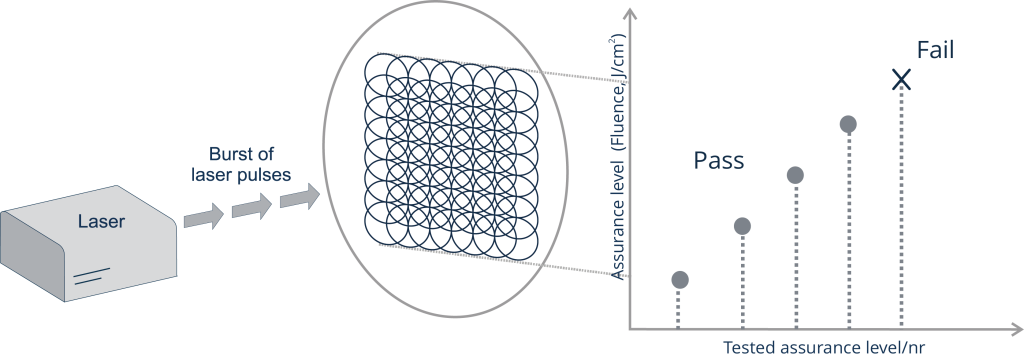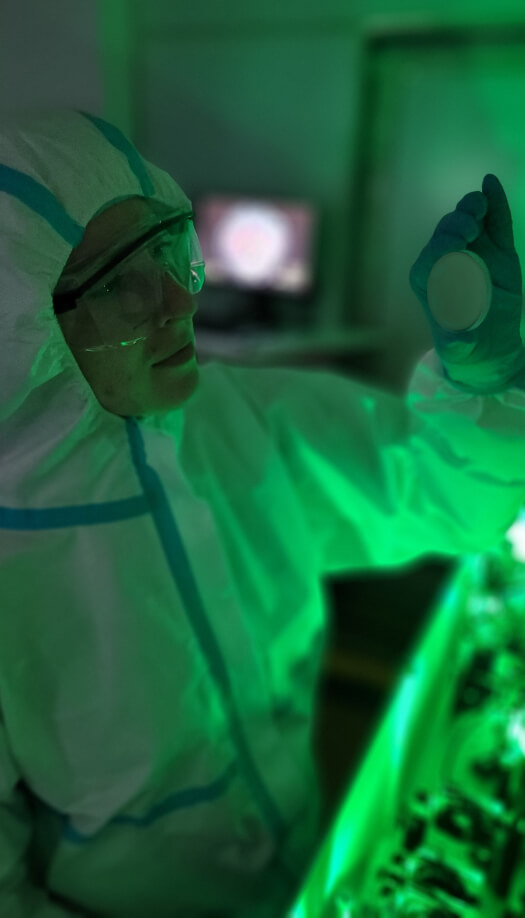
Raster scan LIDT test
Raster Scan Test explained:
Use this test for:
- To test samples with low-density (rare) defects;
- To measure damage density as a function of irradiation level (typically fluence or irradiance);
- To study conditioning, annealing, or laser cleaning effects;
- To study laser damage growth;
- To test/certify large optics;
Test description
During the sub-aperture raster scan test LIDT of the sample is investigated by performing covering large fraction of test sample. A selected area of the sample is scanned by moving laser beam with a spatial overlap between test sites. Spatial overlap is organized in such a way that at least 90% of peak fluence is applied always within entire test area. Surface is checked by microscope before and after scan. If no damage is detected scan is repeated over the same area with increased peak fluence. Starting from very low irradiation level values, it is linearly or non-linearly increased for every new scan until a damage event is detected or the maximum irradiation level of the system is reached. This test if continued above damage initiation threshold may also provide information about the damage density vs irradiation level. (See report example in Downloads section for details).
Known limitations and risks:
- No fatigue (incubation) effects are considered;
- Laser cleaning or conditioning is possible;
- Usually is time-consuming due to multiple microscopy after every scan;
- LIDT can be screened by contamination of surface by ablation products or poor handling;

Most popular test parameters for this test
| Wavelength | Pulse duration(1) | Repetition rate | Coverage within scan area | Interested? |
| 1064 nm | 10 ns | – | > 90 % of peak fluence | ORDER |
| 532 nm | 5 ns | – | > 90 % of peak fluence | ORDER |
| 355 nm | 5 ns | – | > 90 % of peak fluence | ORDER |
| Custom | Check all availability or configure your own at my.lidaris.com | |||
(1) effective pulse duration measured at Full Width Half Maximum
Testing
conditions
Related tests
Show all-
 ISO LIDT Certification Test (21254-1,3)This technique is designed to separate good and bad optics when end-use irradiation conditions are knownread more
ISO LIDT Certification Test (21254-1,3)This technique is designed to separate good and bad optics when end-use irradiation conditions are knownread more -
ISO S-on-1
LIDT test (21254-1,2)The most popular technique used for laser-induced damage threshold (LIDT) characterization of laser optics.read more -
R-on-1
LIDT testTesting protocol, which provides preliminary information about the LIDT of the surface-limited samplesread more -
ISO 1-on-1
LIDT test (21254-1,2)Single-shot technique for determination of “intrinsic” laser-induced damage threshold of coatings.read more

Test bundles and packages
-
Find out more ›
Optics Characterization Bundle for CW regime at 1070 nm
The testing package consists of multiple tests, which are carefully selected to address optics characterization issues at the CW regime. -
Find out more ›
Lifetime + Certification Bundle for Industrial Grade fs-ps Laser Optics
The package consists of several tests carefully selected to address optics certification for critical applications.
more tools
and useful information
-
Find out more ›
Testing conditions
Check out all available laser damage testing conditions (wavelengths, pulse regimes, environments, and more). -
Find out more ›
Laser Damage infobase
Check out a useful glossary of terms and simple explanations related to the main topics of laser damage terminology. -
Find out more ›
Online Fluence calculator
Check out a calculator equipped with laser-related calculus that is frequently required in practice: such as laser fluence. -
Find out more ›
Downloads and docs
Here you can download all information about laser damage testing available at Lidaris. -
Find out more ›
New client guide
Here you will find usefull guidlines and suggestions for everyone, who is new the laser damage field. -
Find out more ›
Orders FAQ
Fast way to find out about test samples prepration, handling, and shipping.
